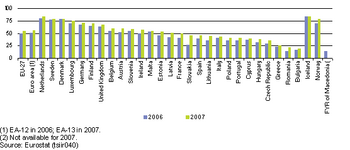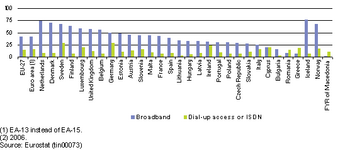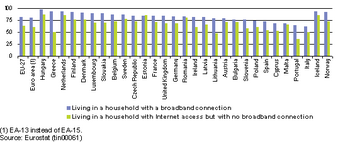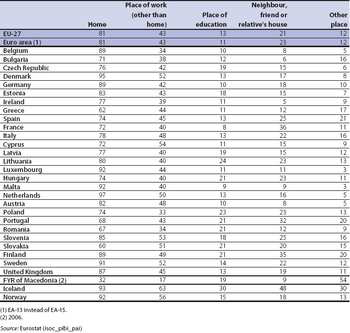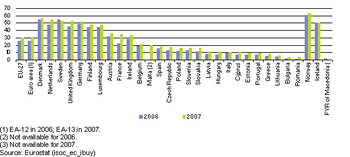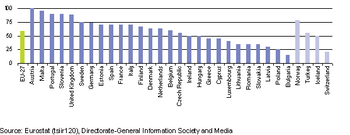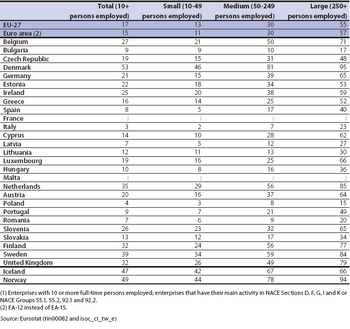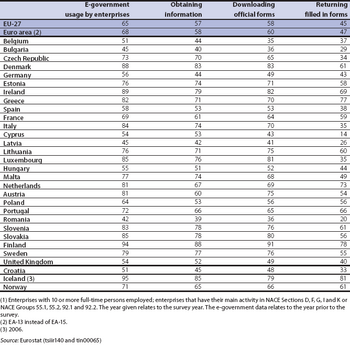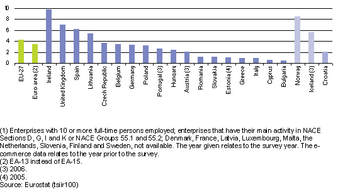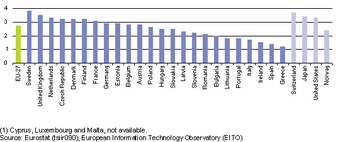Archive:Information society statistics
- Data from September 2008, most recent data: Further Eurostat information, Main tables and Database.
This article presents recent statistical data on many different aspects of the information society in the European Union (EU). Implementing the information society is critical for improving the competitiveness of EU industry and, more generally, to meet the demands of society and the EU economy. Information and communication technologies (ICTs) affect people's everyday lives in many ways, both at work and in the home, and EU policies in this area range from regulating entire industrial sectors to protecting individual privacy.
Main statistical findings
Households and individuals
During the last decade, ICTs have become widely available to the general public, both in terms of accessibility as well as cost. In 2007, in the EU, the increasing use of these technologies was such that, for the first time, a majority (54 %) of households had Internet access. In the same year, among the EU Member States, the Netherlands had the highest proportion (83 %) of households with Internet access, while Sweden, Denmark and Luxembourg reported high shares of at least 75 %.
Widespread and affordable broadband access would appear to be one means of promoting the knowledge-based, information society. The vast majority of households in the EU accessed the Internet using a broadband connection; some 42 % of households had broadband compared to 14 % which had a dial-up or ISDN Internet access. Romania and Greece were the only Member States where a higher proportion of households used a dial-up or ISDN connection to access the Internet. In the EU, some 81% of individuals living in a household with broadband connection accessed the Internet regularly (at least once a week). This result compares with 63 % of individuals living in households that had Internet access but no broadband. In 2007, just over four fifths (81 %) of all Internet users, aged 16 to 74 in the EU, declared that they used the Internet at home, while 43 % of Internet users went online from their place of work.
In 2007, measurements of the supply of e-skills show that more than three quarters of the population in Denmark, Luxembourg, the Netherlands, Sweden and Germany had basic computer skills. The lowest proportions were registered in Bulgaria (32 %) and Romania (29 %). The Member States with the highest proportion of individuals with a high level of computer skills were Denmark and Luxembourg.
The proportion of the population with Internet skills varied from nearly 80 % or more in Denmark, Luxembourg, the Netherlands, Finland and Sweden, to 37 % in Greece, 33 % in Bulgaria and 28 % in Romania. In Finland and Estonia, the proportion of the population with a high level of Internet skills was well above the EU average of 8 %.
In 2007, almost one third (30 %) of individuals made use of e-government initiatives to access a range of public services online, mainly for obtaining information, but increasingly for downloading and filling in forms (such as tax returns). The Nordic Member States, the Netherlands and Luxembourg stood out, as a majority of individuals in each of these countries made use of such e-government services.
Enterprises
Among EU enterprises with 10 or more full-time employees, almost all (97 %) the workforce had an Internet connection in 2007. In addition, more than 90 % of these enterprises accessed the Internet using a broadband connection. An average of 17 % of enterprises with ten or more full-time employees had the facility to allow remote users to connect to their information technology (IT) systems from home. This figure grew considerably as a function of the average size of an enterprise, rising to a 55 % share among those enterprises employing 250 or more people. Enterprises in the Nordic Member States, the Netherlands and the United Kingdom reported the highest propensity to make use of remote access to their IT systems, irrespective of the size of enterprise.
As regards the demand for e-skilled labour, 16 % of enterprises in the EU sought to recruit personnel with ICT user skills during 2006. One fifth of these enterprises had hard-to-fill vacancies because of the lack of ICT user skills. Moreover, 7 % of all enterprises recruited or tried to recruit personnel for jobs requiring ICT specialist skills. Almost half of these enterprises which tried to recruit, had hard-to-fill vacancies for these jobs at the time of the survey in early 2007.
Around two thirds (65 %) of enterprises used e-government services: the majority to obtain information and to download forms (57 % and 58 % respectively), while 45 % of enterprises returned filled-in forms using e-government services. In 2007, the take-up of e-government services among enterprises reflected the relatively high levels of take-up among households in countries such as Denmark, Luxembourg, the Netherlands or Finland. Several other countries – including Ireland, Greece, Italy, Austria, Slovenia and Slovakia – also recorded a relatively high take-up of e-government services by enterprises, in contrast to a relatively low take-up by households. Bulgaria, Latvia and Romania were the only countries to report a minority of enterprises making use of e-government services.
During 2007, in the EU, some 15 % of enterprises received orders online, which was about half the proportion of enterprises (29 %) that used the Internet to place orders to purchase goods or services. Across the Member States, the general pattern shows a considerably higher proportion of enterprises have made purchases online, when compared to those that have received orders online (probably reflecting the greater complexity of setting up an online selling system as compared with making purchases). In 2007, a third of all enterprises in Denmark received orders online, while the corresponding shares were equal to or above one quarter in the United Kingdom, Ireland, Sweden and the Netherlands. In 2007, in contrast, a majority of enterprises in Ireland and Germany (55 % and 52 % respectively) made purchases online, while upwards of 40 % of all enterprises in the United Kingdom, Sweden, Belgium and Austria made purchases online.
In 2007, in the EU, the proportion of total turnover accounted for by e-commerce via the Internet equated to 4.2 %, with only a handful of countries – Ireland, the United Kingdom, Spain and Lithuania – reporting that e-commerce represented more than 5 % of their total turnover.
Compared with its main competitors, the EU has a relatively low share of ICT expenditure when expressed as a share of GDP. Indeed, in 2006, in the EU, expenditure on information technology represented 2.7% of GDP compared with 3.4 % in Japan and 3.3 % in the United States.
Data sources and availability
Statisticians are well aware of the challenges posed by rapid technological change in areas related to the Internet and other new applications of ICTs. As such, there has been a considerable degree of evolution in this area, with statistical tools being adapted to satisfy the new demands for data. Statistics within this domain are reassessed on an annual basis in order to meet user needs and reflect the rapid pace of technological change.
The data presented within this section are from Eurostat’s Survey on information and communication technologies in households and by individuals, and Survey on information and communication technologies in enterprises. These annual surveys on ICT use in enterprises and in households/by individuals can be used to benchmark ICT-driven developments. While the surveys initially concentrated on access and connectivity issues, their scope has subsequently been extended to cover a variety of subjects (including, for example, e-government and e-skills) and socio-economic breakdowns, such as regional diversity, gender specificity, age, educational differences and the individual’s employment situation in the household survey, or a breakdown by size (small, medium, large) in the enterprise survey. The scope of the surveys with respect to different technologies is also adapted so as to cover new product groups and means of delivering communication technologies to end-users (enterprises and households).
Households are defined as having at least one member in the age group 16 to 74 years old. Household Internet access refers to the percentage that have an Internet access, so that anyone in the household could use the Internet at home, if so desired, simply to send an e-mail. Internet users are defined as all individuals aged 16-74 who had used the Internet in the previous three months. Regular Internet users are individuals who used the Internet, on average, at least once a week in the three months prior to the survey (in general, during the first quarter of 2007).
The technologies most commonly used to access the Internet are divided between broadband and dial-up access. Broadband includes Digital subscriber lines (DSL) or xDSL and uses technology that transports data at high speeds. Broadband lines are defined as having a capacity equal to or higher than 144 kbit/s. A dial-up access using a modem can be made over a normal or an ISDN telephone line and, due to its limited bandwidth, it is often referred to as narrowband.
A computer is defined as a personal computer that is run using one of the main operating systems (Macintosh, Linux or Microsoft); hand-held computers or palmtops (PDAs) are also included. Individuals were asked if they had had experience of carrying out selected activities in order to measure their level of basic computer skills. The six computer-related activities were:
- copying or moving a file or folder
- using copy and paste tools to duplicate or move information within a document
- using basic arithmetic formulae to add, subtract, multiply or divide figures in a spreadsheet
- compressing files
- connecting and installing new devices, e.g. a printer or a modem
- writing a computer program using a specialised programming language.
The number of activities they carried out determined the level of an individual’s skills as:
- low level: 1 or 2 activities
- medium level: 3 or 4 activities
- high level: 5 or 6 activities
The ordering of goods and services by individuals includes:
- confirmed reservations for accommodation
- purchasing financial investments
- participation in lotteries and betting
- Internet auctions
- information services from the Internet that are directly paid for.
Goods and services that are obtained via the Internet for free are excluded. Orders made by manually written e-mails are also excluded. The indicator shows the percentage of individuals aged 16-74 who have used the Internet, in the 12 months prior to the survey, for ordering goods or services.
The survey on ICT usage in enterprises covers enterprises that have 10 or more employees. The activity coverage is restricted to those enterprises whose principal activity is within NACE Sections D, F, G, I and K and Groups 55.1, 55.2, 92.1 and 92.2. In other words:
- manufacturing
- construction
- distributive trades
- hotels and accommodation
- transport and communication
- real estate
- renting and business activities
- motion pictures and video activities
- radio and television activities.
Internet access among enterprises is measured as the proportion of the total number of people employed who have access either directly to the Internet or can access it via a broadband connection. This indicator is considered as a proxy for productivity within enterprises. The availability of broadband is measured by the percentage of enterprises which are connectable to an exchange and have been converted in order to support xDSL-technology. This conversion is either to a cable network that has been upgraded for Internet traffic, or to other broadband technologies.
The indicator measuring enterprise turnover from e-commerce is shown as a percentage of total turnover. Information comes from the surveys carried out by the National Statistical Institutes on usage of information and communication technologies (ICT) by enterprises. The indicator is calculated as the amount of the enterprises' receipts from sales through the Internet expressed as a percentage of their total turnover. Sales through other networks are not included, leaving out, for instance, Electronic Data Interchange (EDI)-based sales. Only enterprises with 10 or more employees are included. The year given relates to the survey year while the e-commerce data relates to the year prior to the survey. E-commerce is defined as ordering or selling goods and services over computer-mediated networks. Online purchases or orders received exclude those relating to manually typed e-mail purchases or orders received. The indicator on enterprises having received orders or made purchases online covers online selling via Internet and EDI or other networks within the previous year. Only enterprises buying/selling more than 1 % online are included.
Indicators, relating to the online access to public services, show the percentage of 20 basic services that are fully available online. In other words, the online services for which it is possible to carry out a fully electronic case handling. For example, if in a country 13 of the 20 services were measured as being 100 % available online but one service is not relevant (i.e. does not exist), the indicator is 13/19, which is 68.4 %. Measurement is based on a sample of URLs of public websites agreed with Member States as relevant for each service.
The indicators concerning the use of e-government services are based on usage during the three months prior to the survey for individuals and one year in the case of enterprises. For enterprises, the year given relates to the survey year, while the e-government data relates to the year prior to the survey. E-government services concern interaction with public authorities in one or more of the following activities: obtaining information from public authority websites, downloading official forms and submitting completed forms.
Data on IT expenditure covers expenditure for IT hardware, equipment, software and other services.
Context
Information and communication technologies (ICT) are considered as critical for improving the competitiveness of European industry and, more generally, to meet the demands of society and the economy. ICT affects many aspects of everyday lives, at both work and in the home, and European Union policies in this area range from the regulation of entire industrial sectors to the protection of an individual’s privacy.
The EU policy framework for ICT is the i2010 initiative ’A European Information Society for Growth and Employment’ which seeks to boost efficiency throughout the EU economy by means of the wider use of ICT. The initiative is designed to promote an open and competitive digital economy, research into information and communication technologies, as well as their application to improve social inclusion, public services and the quality of life. Indeed, at the heart of the policy is a desire to ensure that social and geographical differences are overcome, thus creating a fully inclusive digital society. The i2010 initiative has three main priorities:
- creating a 'Single European information space' which promotes an open and competitive internal market for information society and media services;
- stimulating the information society – to strengthen investment in innovation and research in ICT; and
- exploiting the benefits of ICT – to foster inclusion, better public services and quality of life through the use of ICT.
Digital literacy and e-skills are crucial to increasing participation in the information society. The 2007 results of Eurostat’s household survey of information and communication technologies presented here include findings on the levels of computer and Internet skills of the population. According to a Communication from the European Commission on 'e-Skills for the 21st century: fostering competitiveness, growth and jobs’, there is evidence for skills shortages across Europe, with a lack of up to half a million people with advanced networking technology skills, while enterprises report a skills shortfall for ICT practitioners, particularly in ICT strategy, security and new business solutions.
The i2010 benchmarking framework has addressed specific module(s) on e-skills in the 2007 survey(s).
Having undergone a mid-term review, an updated i2010 strategy was presented in April 2008, addressing key challenges for the period 2008-2010.
This was followed by a European Commission 'Communication on future networks and the Internet', which outlined the full promise of the social and economic potential of the Internet in the future, based on the premise of high-speed Internet being available to all, and which is internationally open and competitive, secure and safe to use, with transparent and effective governance. These fundamental conditions of accessibility, openness, transparency and security form the basis of the European Commission’s short-term agenda for the Internet of the future, as summarised by six actions:
- the construction of high-speed Internet infrastructures that are open to competition and give consumers real choices;
- promoting access for all to a good-quality Internet connection at an affordable price;
- keeping the Internet open to competition, innovation and consumer choice;
- launching a debate on the design and development of the Internet of the future;
- providing clear guidelines on the implementation of existing rules on data protection and a coherent strategy for a secure Internet of the future;
- taking into account the crucial role that is played by international policy, regulatory dialogue and research co-operation in all these developments.
Broadband technologies are considered to be important when measuring access to and use of the Internet, as they offer users the possibility to rapidly transfer large volumes of data and keep their access line open. The take-up of broadband is considered to be a key indicator within the domain of ICT policy-making. Widespread access to the Internet via broadband is seen as essential for the development of advanced services on the Internet, such as e-business, e-government or e-learning. In the EU, broadband growth has continued in recent years and 42 % of all households have broadband. Digital Subscriber Lines (DSL) remain the main form of delivery for broadband technology, although alternatives, such as the use of cable, satellite, fibre optics and wireless local loops are becoming much more widespread.
Further Eurostat information
Publications
- Science, technology and innovation in Europe
- Science, technology and innovation in Europe – 2007 edition pocketbook
Main tables
- Information society, see:
- Information society statistics
- Policy indicators (t_isoc_pi)
- i2010 Benchmarking indicators (t_isoc_pi_benchmark)
- Information society: Structural Indicators (t_isoc_si)
- Telecommunication services (t_isoc_tc)
- Computers and the Internet in households and enterprises (t_isoc_ci)
- E-skills of individuals and ICT competence in enterprises (t_isoc_sk)
Database
- Information society, see:
- Information society statistics
- Policy indicators (isoc_pi)
- Information society: Structural Indicators (isoc_si)
- Telecommunication services (isoc_tc)
- Computers and the Internet in households and enterprises (isoc_ci)
- E-Commerce by individuals and enterprises (isoc_ec)
- E-skills of individuals and ICT competence in enterprises (isoc_sk)
- Regional Information society statistics (isoc_reg)
